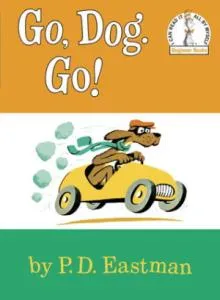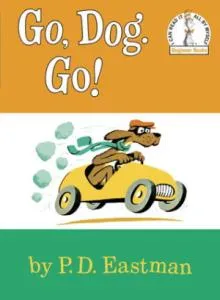For many, the vibrant, energetic world of “Go, Dog. Go!” evokes fond memories of early childhood reading. This iconic book, filled with dogs of all shapes, sizes, and colors, navigating their world in a delightful array of vehicles, often gets mistakenly attributed to the legendary Dr. Seuss due to its similar whimsical style and its publication under the “Beginner Books” imprint. However, it’s crucial to clarify that “Go, Dog. Go!” is, in fact, the brilliant creation of P.D. Eastman, an acclaimed author and illustrator in his own right, known for other beloved children’s titles like “Are You My Mother?”. This article delves into the unique characteristics of Eastman’s work, exploring its core purpose, its perceived controversies, and its lasting impact on early literacy, distinguishing it clearly from the works of Dr. Seuss while acknowledging its important place in children’s literature. You might also be interested in other classics like clifford the big red dog first book.
The Simplicity of “Go, Dog. Go!”: A Primer for Young Readers
At its core, “Go, Dog. Go!” is a masterclass in simplicity, often likened to a “baby’s first book of words.” The narrative begins with fundamental concepts: “Dog,” then “Big dog,” followed by “Little dog,” before progressing to “Big dogs and little dogs.” This deliberate progression introduces young readers to basic vocabulary, noun phrases, and the concept of plurals without the complexity of full sentences. The book is rich with visual cues, depicting dogs on different-colored trees (“A red dog on a blue tree. A blue dog on a red tree.”) and an abundance of dogs in various cars, engaging children with prepositions and their opposites. This style, though perhaps seeming “boring” to an adult accustomed to intricate plots, serves a highly specific and valuable educational purpose: decoding practice for emergent readers.
 A dog sitting on top of a red house with another dog underneath, a scene from Go, Dog. Go!
A dog sitting on top of a red house with another dog underneath, a scene from Go, Dog. Go!
This intentional repetition and straightforward language are not mere oversight but a foundational strategy in early literacy. Children in the 3-7 age range, the book’s target audience, are not learning the meaning of words like “blue” or “dog”; they are learning to read these words through phonics and sight recognition. The book provides ample opportunity to practice these commonly encountered words over and over, allowing young minds to decode effortlessly. This focus on practice over complex literary elements like character development or overarching themes ensures that children remain 100% focused on the crucial task of learning to read.
The “Hat Dog” Debate: Unpacking Interpretations of Gender Dynamics
One recurring element in “Go, Dog. Go!” that has sparked considerable online discussion is the interaction between two specific dogs, often interpreted as a subtle commentary on gender roles. Throughout the book, a presumably male dog encounters a feminine dog, who repeatedly asks if he likes her hat. She dons a different hat each time, and consistently, his reply is negative, leaving her visibly disappointed. This pattern persists until the book’s concluding spread, where he finally expresses approval of her hat, and they are shown driving off together into the sunset.
This sequence has led some critics to argue that it inadvertently reinforces the cultural message that females need male validation, with the “reward” for pleasing him being his companionship. While some interpret this as reflecting outdated gender stereotyping, others view it simply as a repeated narrative device within a book designed for simplicity, not complex social commentary. The interaction’s ambiguity allows for diverse interpretations, highlighting how even the most straightforward children’s stories can be viewed through different lenses as societal perspectives evolve. Consider exploring other related canine narratives like charles bukowski love is a dog from hell.
 A collection of dogs in various colorful hats, some expressing disappointment
A collection of dogs in various colorful hats, some expressing disappointment
Beyond the Narrative: “Go, Dog. Go!” as an Early Reading Tool
Initial readings of “Go, Dog. Go!” might lead some to conclude that it lacks a compelling story, presenting merely a series of dogs “doing various things” without a clear plot progression. Indeed, the dogs drive around, almost have mishaps, sleep in a giant bed, party, and then gather atop a very tall tree for another celebration. However, this perceived lack of a traditional story arc is not a flaw but a feature, especially when considering the book’s primary audience and purpose. It’s not a narrative-driven tale meant to captivate with suspense or intricate character development, but rather a carefully constructed tool for beginning readers.
The repetition of simple phrases, the clear illustrations depicting actions and objects, and the focus on basic concepts like colors, sizes, and prepositions are all designed to facilitate word recognition and reading fluency. Children learning to read require predictable patterns and high-frequency words presented in an accessible manner. The book provides decoding practice, enabling young readers to build confidence as they successfully read words and short phrases independently. The journey through “Go, Dog. Go!” is less about the dogs’ adventure and more about the child’s journey into reading itself. For those interested in the history of beloved dog characters, clifford the big red dog 1963 offers another perspective.
 Multiple dogs driving various cars, some with open tops, in a lively procession
Multiple dogs driving various cars, some with open tops, in a lively procession
P.D. Eastman’s Legacy: Distinguishing “Go, Dog. Go!” from Dr. Seuss
Despite its frequent association with the whimsical world of Dr. Seuss, “Go, Dog. Go!” was neither written nor illustrated by Theodor Geisel (Dr. Seuss). It was penned by Philip Dey Eastman, a prolific author and illustrator who worked closely with Dr. Seuss on the Beginner Books series. Eastman’s distinct style, characterized by clear lines, vibrant colors, and straightforward storytelling, is evident in his other celebrated works, such as “Are You My Mother?” and “A Fish Out of Water.” While Dr. Seuss’s books often feature complex rhymes, fantastical creatures, and moral undertones, Eastman’s contributions to early literacy are grounded in teaching fundamental concepts through simpler narratives and explicit visual aids.
 Dogs of different colors climbing and sitting on various colored trees, a vibrant scene
Dogs of different colors climbing and sitting on various colored trees, a vibrant scene
This distinction is important not only for attributing authorship correctly but also for appreciating the unique contributions of both authors to children’s literature. Dr. Seuss was instrumental in shaping the “Beginner Books” philosophy, encouraging simple vocabulary and engaging stories to help children learn to read. P.D. Eastman, under this guidance, crafted books that perfectly embodied this mission, making “Go, Dog. Go!” a cornerstone of early reading education. You may also enjoy learning about clifford the big red dog norman bridwell.
Conclusion
“Go, Dog. Go!” by P.D. Eastman stands as a testament to the power of simplicity in children’s literature. While it may not offer the complex narratives or overt moral lessons found in some other books, its strength lies in its meticulous design as a “first reader” – a vital tool for children embarking on their reading journey. From introducing basic vocabulary and concepts to providing essential decoding practice, the book serves a specific, invaluable purpose. Despite some critical interpretations regarding its social dynamics, its enduring popularity underscores its effectiveness in engaging young minds and fostering a love for reading. It remains a foundational text, reminding us that sometimes, the most profound lessons are delivered through the simplest of tales, and that great books for children don’t always need to be from Dr. Seuss to be classics.
